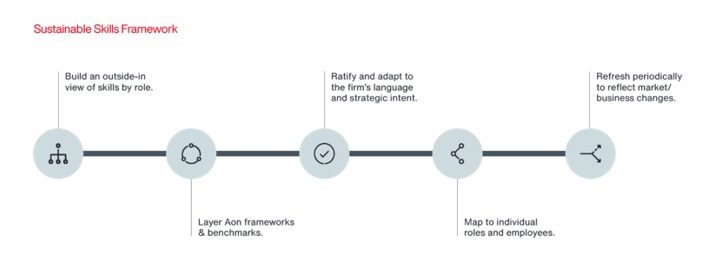HRHQ Sponsored Content
by Dean Callaghan, C. Psychol., Ps.S.I, Managing Director at Aon’s Human Capital Solutions
HR plays a crucial role in enabling companies to achieve their strategic goals in a complex and challenging environment that’s transforming the workplace. Some of the factors impacting the workforce include:
- A more volatile business environment triggered by challenging macroeconomic trends and geopolitical instability
- A more dispersed workforce and talent pool due to hybrid and remote work
- Ongoing difficulty with attracting and retaining talent
- Demand for talent with the right skills for the future
The HR function has a unique opportunity to partner with other areas of the business to address these challenges in a holistic way. Attracting talent in this market is challenging, companies’ hiring budgets are more constrained, and the need for future skills in the workforce is greater than ever. These forces create an opportunity for companies to double down on their retention, engagement and re/upskilling programs.
Future Skills Planning Has Become More Urgent as the Skills Gap Persists
There are many questions to sort out in assessing and strengthening the future skills needed in the workforce. How do you know which current employees have the potential to learn, change and adapt? How do you reward for hot skills? Where do you source new talent with these skills and help existing employees through the transition?
From frameworks to cost planning, here are five helpful steps to guide you on the right path forward on your future skills journey.
How to Future-Proof Your Workforce Skills Strategy in 5 Steps
- Establish a Sustainable Skills Framework
Business is being disrupted and the requirements needed to be successful in the workplace are changing. Leaders must therefore assess what skills they need for certain roles both today and into the future.
In order to assess for these types of future-leading skills, employers will benefit from a skills framework — a structure that allows organisations to develop and execute a strategy on how to buy and maintain the necessary skills.
We work with clients across sectors to develop workforce skills frameworks that elevate a company’s ability to improve their strategies around skills-based pay, career pathing, workforce planning and future-focused job architectures.

- Connect Your Skills Framework to Your Job Architecture
In this rapidly changing and converging business environment, many employers are evaluating their job architecture at the same time as they are assessing what skills they require among their workforces. These two activities have clear synergies; the good news for HR leaders is that a skills framework can and should be integrated with your job architecture.
Connecting your workforce skills framework to your job architecture is an incredibly powerful combination. While you can do one without the other, the result is usually sub-optimal. Job architecture is a firm-wide structure that defines roles and jobs, leading to increased transparency around organisational mobility, including both lateral and vertical career progression. Linking skills to architecture helps determine exactly what is needed to explain the connection to learning programs and offerings. We all want career transparency, but actually getting there requires both.
Direct benefits include:
- Understanding your workforce needs
- Effectively targeting skills gaps
- Strengthening your firm’s overall workforce resilience
- Integrate Your Skills Framework with Current HR Processes
Ensuring there is a common understanding and language for employees to drive organization strategy and goals is critical. A future-proofed skills framework that’s aligned to business strategy will have a significant impact on your HR ecosystem, from job architecture as discussed above, to organisational effectiveness in identifying gaps or overlaps, performance ratings, career pathing and opportunities, recruitment and rewards, training possibilities and psychometric assessments. With skills data, organisations can also connect workers with internal opportunities, such as projects, gigs and new roles, to deliver more personalized experiences and help nurture career growth.
The use of online assessment tools then validates what skills people truly have by measuring readiness through certifications, technical assessments, soft or competency-based assessments, as well as valuations for hard skills.
- Understand Cost Implications and Value-Add
Always understand and weigh any cost implications associated with future skills planning. How much time and money would you save by focusing on skills you may already have versus hiring external talent? Reskilling and upskilling are two effective ways to address skill gaps. Even further, companies that openly make reskilling and upskilling part of their employee value proposition and total rewards strategy will build trust and understanding, leading to increased engagement and loyalty. But how can you be sure this approach is right for your business? Increasingly sophisticated human resources information system platforms make it much easier to capture and maintain skills information, so your decisions are always informed.
- Use Data to Make Talent Decisions
HR technology and artificial intelligence (AI) allow firms to use skills through the entire employee life cycle in different ways. However, to unleash the power of the AI, you need to know how skills link to the roles in the organisation, and then keep tabs on how they change over time. Far too often, companies have people frameworks that don’t speak to each other and lack clear connection points. Aon partner with organisations to help determine how to make the most of the resources they have. Using interconnected systems and data to make decisions around talent, staffing and workforce planning is the key to success. Doing so also provides timely benchmarks and opportunities for improved agility and the ability to maintain a resilient workforce that adapts and responds better to changing business demands.
To find out more about how you can start your skills journey or complement the work you’re already doing, contact [email protected]










































